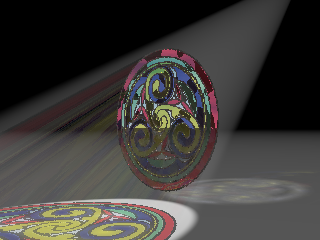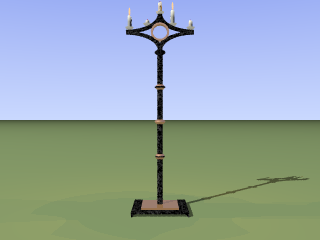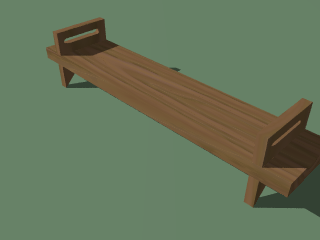 |
This is the image that started it all. Once I figured out how to make the
window using carved isosurfaces I built this, added a spot light and some
media and rendered. Once I saw it I knew I had to make a complete image for
the IRTC. Note how jagged the window is, the piece of art I originally used was only
256x256 (from http://www.aon-celtic.com/).
I later re-did it by hand much larger and with added lead lines. Note also
the photons. |
| I wrote a macro to build stone walls with isosurfaces (who hasn't?). In this
image I was tweaking the stone functions to make the floor. I also ended up
using this for the crypts and the columns |
 |
 |
Starting to come together. Note how rough the walls are. |
| Photons and Ghost test. Originally the crypts were all going to look the same
but with different art. I later figured that was too dull, and not very
realistic... |
 |
 |
So I re-worked crypts. Notice I have a lot of switches I can throw for faster
rendering when I want to work on just one part. These switches can replace
the floor and wall with stand-ins, remove the glass from the window, remove
the columns and other things. The image_map out the window is from a business
trip to Sand Point, Idaho. Only I would be sent on a trip to 'the gateway
to ski country' in mid summer! The size of the window is off because I was also
in the middle of replacing it with my bigger, hand drawn one. |
| Time to place the media box. Originally it was only placed where the light fell
through the window, but when I added the lit candles I had to resize it. This
is a reverse angle long shot. |
 |
| And now some props. First came the candelabra. I had never done much in Povray
with trying to model something realistic. I was so pleased with how well this
CSG turned out it gave me the confidence to model the rest of the props myself
rather than look for pre-made meshes. This is modeled after one used
in Disney's The Hunchback of Notre Dame. |
 |
 |
Now to put a fence around the left hand crypt. I made it as a macro and
doing it inspired me to make the lower round topped fence below the window.
Since there was a fence there now it begged for something to be behind it.
This led to... |
| The Celtic Cross. I was going to do some fancy carving in it's face but
time was running short by this point and it would not read well through
the media anyway. |
 |
 |
The last prop that got finished, the kneeling bench. It was going to house
some other small props, like a rose and a votive candle that would pick out
the props and highlight the carving on the front of the central crypt. After
seeing what the lights on the candelabra did to the rendering time however
I opted out of adding any more lights, and ran out of time for any more
props anyway. |
| The final piece of the puzzle, the boy freshly imported from Poser. To my
surprise he had been mirrored from left to right. |
 |
|
|





















